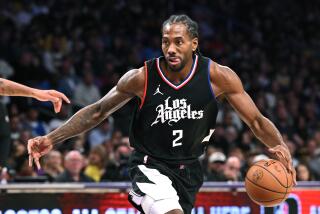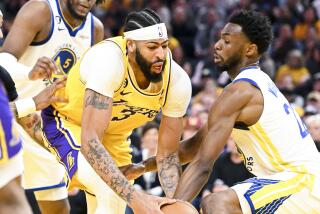Knee-Deep in Pain Is Never a Good Place to Be
- Share via
On the Chinese calendar, 1997 will go down in history as the Year of the Ox. But for sports fans--especially basketball lovers--this year is beginning to shape up (or break down) as the Year of the Injured Knee.
Last week, Laker Shaquille O’Neal, recovering from a sprained ligament in his right knee, buckled on a landing and hurt his left knee, ending up with a diagnosis as long as his arm: partially torn ligament, hyperextended joint, torn soft tissue around the knee and a fractured bone.
Then teammate Robert Horry was sidelined with a sprained medial collateral ligament in the left knee.
San Antonio Spur Vernon Maxwell sat out the second half of a Spurs-Utah Jazz game with a sore knee.
Derek Anderson of the University of Kentucky was sidelined after having his torn anterior cruciate ligament reconstructed.
And in case you missed this announcement, last week the knee was named “the most often treated anatomical site” by the American Academy of Orthopaedic Surgeons, based on a survey of 17,561 orthopedic surgeons in the United States.
Before you say, “Yeah, yeah, they’re biased,” listen to the stats:
* Almost 5 million people “limp into the offices” of orthopedic surgeons each year because of knee problems.
* About 3 million visits are injury related, the rest due to arthritis or other knee-related problems.
* About 1.4 million people a year head to hospital emergency rooms for knee problems, most of them injuries.
So, Shaq’s got knee problems, you got knee problems--or chances are, you will down the line.
But it probably won’t affect your career or your orthopedic surgeon’s practice quite as intensely. Consider the pressure when orthopod-meets-professional-athlete-in-the-exam-room while the world waits to hear the outcome.
On Thursday morning, Laker team physician Dr. Steve Lombardo, who cares for O’Neal and Horry, was too busy tending to patients without multimillion-dollar contracts and politely declined an interview request. But his colleague, Dr. Neal S. ElAttrache, orthopedic surgeon specializing in sports medicine at Kerlan Jobe Orthopedic Clinics who has operated on many professional athletes, filled in the scenario.
“It’s a high-pressure situation for the orthopedic surgeon because he is going to be accountable not only to the player but to the player’s agent, to those who pay the player’s salary, the press and the public. He’ll be scrutinized by armchair quarterbacks and doctors across the country.”
To cope with the pressure, ElAttrache and others say they follow a simple guideline: “The person is a patient first”--a patient with a bum knee.
Why is the knee joint--the largest joint in the body--such a pain in the butt?
“The knee is vulnerable for two reasons,” says Dr. James Fox, senior partner at the Southern California Orthopaedic Institute in Van Nuys.
“It is basically a ball sitting on a flat surface . . . held together by thin strings about the size of your little finger called ligaments.”
It’s also a very busy little joint, moving just about every which way. Fox puts it more eloquently: “It’s a multiplanar joint. The knee ‘hinge’ goes forward and backwards and sideways. It rotates out about 60 degrees and internally about the same. So it slides, glides and also rolls.”
Now, enter those gravity-defying jumps for rebounds. Athletes can land with 16 to 20 times their body weight after such a jump, ElAttrache says. And being in top condition is double-edged sword when it comes to knee injuries. “When you are conditioned in such a way that you can run at high speed, like NBA or NFL players, you are going to generate even more force on the knee joint,” ElAttrache says. “More often than not, knee problems are noncontact injuries.”
Whether you injure your knee by yourself or have help, the possible knee injuries could fill a textbook. Here are some of the biggies:
* Contusion is common. Usually a little rest is all that’s needed to get back into action.
* Among nonprofessional athletes, “overuse” injuries from too much activity can also lead to knee pain, says Dr. Thomas Schmalzried, associate medical director of the Joint Replacement Institute at Orthopaedic Hospital.
* Torn knee cartilage--often referring to a torn meniscus, the tough rubbery cartilage attached to the ligaments--is often sustained by athletes.
Problems can also occur with the knee ligaments: the anterior cruciate, the posterior cruciate and the collaterals.
So how best to protect this temperamental joint?
“The best advice is to get regular, low-level exercise, three to four times a week,” Schmalzried says. “Any time you start to increase exercise, do it gradually.”
(BEGIN TEXT OF INFOBOX / INFOGRAPHIC)
Read All About the Knee
Don’t know your knee’s PCL from its ACL? Does “lateral collateral” sound like something you offer in exchange for a loan?
Here’s help.
The knee is the body’s largest joint and one of the most vulnerable.
It is made up of the lower end of the thigh bone (femur), which rotates on the upper end of the shin bone (tibia) and the knee cap (patella), which slides in a groove on the end of the femur.
The job of the knee ligaments is to control motion by connecting bones and bracing the joint against abnormal types of motion.
The ligaments, please: The anterior cruciate ligament (ACL) and posterior cruciate ligament (PCL) crisscross within the joint. The lateral collateral and medial collateral ligaments are outside the joint. Both pairs of ligaments connect upper and lower leg bones.
* Source: The American Academy of Orthopaedic Surgeons
Save Those Knees
Short of covering the knees in bubble wrap, what’s the best way to protect them?
* Lose weight if you’re overweight. Even 20 pounds can put too much pressure on the knees, says Dr. James Fox, senior partner at Southern California Orthopedic Institute in Van Nuys.
* Athletes, watch your playing surfaces. Grass is much easier on the knees than artificial turf, says Dr. Neal S. ElAttrache, orthopedic surgeon specializing in sports medicine at Kerlan Jobe Orthopedic Clinics. Concrete is definitely the worst surface. Parquet flooring isn’t ideal either--there can be a lot of friction between shoes and the floor.
* Warm up before exercising and stretch when you’re done.
* Strengthen the quadriceps muscle on the front of the thigh, the hamstring on the back, and the calf muscles--all muscles that support or stabilize the knee.
* If you have knee problems, find out from your doctor which exercises and activities to avoid.
* Forget about preventive knee bracing, which gets a thumbs down from orthopedic experts. No studies have so far proven its value.
More to Read
Go beyond the scoreboard
Get the latest on L.A.'s teams in the daily Sports Report newsletter.
You may occasionally receive promotional content from the Los Angeles Times.










